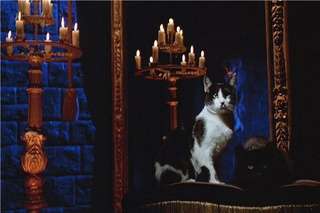Inferno (1980 film)

A 1980 Italian horror film by Dario Argento, not to be confused with the novel of the same name.
Rose Elliot, a poetess living in New York, purchases a book from a local antiques dealer. Written by an alchemist known as Varelli, the book explains how the author was commissioned by three evil (and very powerful) witches to construct stately mansions for them, from which they rule over the world with insanity, grief and despair. Realizing that the apartment she now resides in might be the home of Mater Tenebrarum, the Mother of Darkness, Rose writes to her brother Mark, currently studying music in Rome, to warn him of her fears.
Mark returns to New York, and finds that Rose has vanished. Taking up residence in her apartment, Mark tries to piece together the whereabouts of his sister, only to discover that her initial fears were horribly correct.
The second film in a loose trilogy (between Suspiria and The Mother of Tears), in terms of storytelling Inferno is the most alien of the three. While Suspiria walked a thin line between murder mystery and surreal horror, Inferno dispenses with any sort of narrative structure, instead running on a dream logic that makes no concessions to reality. This has made it extremely polarizing among fans of Argento, and of Italian horror in general. To its credit, many notable fans, including critic Kim Newman, consider it one of the most underrated horror films of the 1980's.
- Alien Geometries: The far out architecture of Rose's apartment (to say nothing of the Tanz Akademie or the Palazzo Varelli) makes more sense when you realize it was designed by a medieval alchemist.
- Big Bad: Mater Tenebrarum who is disguised as the nurse
- Cats Are Mean: Easily one of the most unintentionally hilarious examples ever committed to film.
- The Butler Did It: Subverted, though it's implied not for lack of trying.
- The Cruella: Kazanian, although considering events earlier in the film, he may be somewhat justified.
- Decoy Protagonist: Several.
- Early-Bird Cameo: Mater Lachrymarum, who serves as the main antagonist in Mother of Tears, makes a brief appearance in this film, although played by a different actress.
- Encyclopedia Exposita: The Three Mothers, by E. Varelli.
- Enforced Method Acting: Leigh Mc Closkey was forced to do his own stunts during the firey climax, as his stunt double had broken a leg.
- The Faceless: In contrast to Suspiria, where the entire faculty belongs to the coven, the faces of Tenebrarum's coven and servants are appropriately masked by shadow at all times.
- Failure Hero: Unlike Suzy in Suspiria, Mark had done nothing to contribute to the villains's defeat. Tenebrarum died in the fire that she had unintentionally caused on her own through one of her murders.
- The Hecate Sisters: The Three Mothers.
- Hey, It's That Guy!: Alida Valli as Carol, the caretaker, and Leigh Mc Closkey (of Dallas fame) as Mark.
- Makes Just as Much Sense in Context: Between the insane colors and architecture, good luck figuring out what's happening at any given time. It does, however, look very cool.
- Narm: "Help help, the rats are eating me!"
- Never Found the Body: Every last death other than Varelli's. This is partly what leads to the titular inferno. It's entirely possible that Mother of Shadows does not die at all, as her guise as Death simply vanishes amid flames.
- Pinball Protagonist: Played straight, but arguably proof that Tropes Are Not Bad. Mark survived and may have played a role in the death of Mater Tenebrarum, but even at the end has little more than faint hints as to what happened.
- Scenery Porn
- Soundtrack Dissonance: Perhaps the best music for sneaking around the Big Bad's lair isn't bombastic Ominous Latin Chanting set to synthesized and up-tempo organ.
- What Could Have Been: James Woods was considered for the lead role, but was already committed to Videodrome at the time.